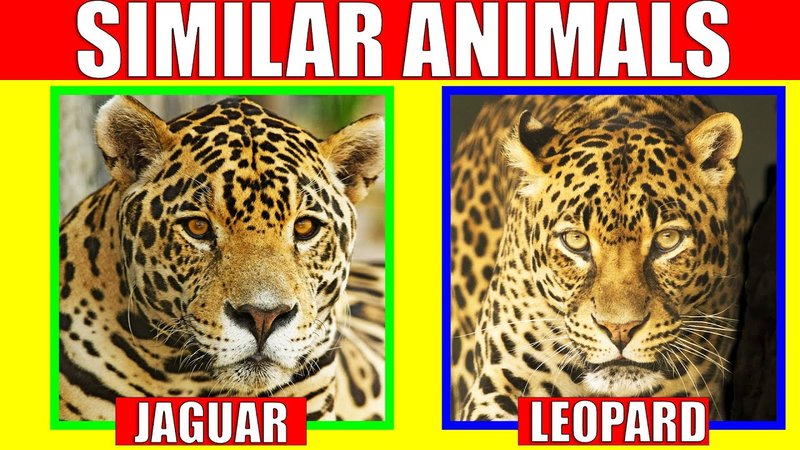
Let’s dive into the world of big cats and see what makes each one unique. We’ll explore their habitats, behaviors, and key features to help you distinguish them from panthers and each other. Whether you’re a budding wildlife enthusiast or just someone curious about these magnificent creatures, I’ve got you covered! Grab a cup of coffee (or tea), and let’s get into it.
1. Leopard
Leopards are often mistaken for panthers, especially when they’re sporting their dark, spotted coats. To the untrained eye, this sleek feline could easily pass as a panther, but there are some important differences. Leopards have distinctive rosettes—those are those beautiful spots that look like small roses. Their coat can range from golden to a darker hue, and they often have lighter patches around their eyes and on their face.
You can typically find leopards across sub-Saharan Africa and parts of Asia. They are incredibly adaptable, thriving in various environments like savannas, forests, and even mountains. If you spot a big cat lounging on a tree branch during the day, that’s likely a leopard! Unlike panthers, leopards are known for being more social and sometimes even hunt in pairs.
2. Jaguar
Ah, the jaguar—a magnificent creature native to Central and South America. Jaguars are similar to leopards in appearance but are usually bulkier. One of the easiest ways to tell them apart is by looking at their rosettes, which are larger and tend to have a central spot in the middle. Jaguars have a more powerful build, with strong jaws designed to crush the skulls of their prey, making them formidable predators.
These cats are known for their love of water, which is unusual in the big cat family. They often hunt in or near rivers, preying on fish, caimans, and even capybaras. If you ever hear a loud, rasping cough-like sound, you might just be in the presence of a jaguar!
3. Cheetah
Cheetahs might be the fastest land animals, but they’re quite different from panthers. Unlike the stocky build of a panther, cheetahs have a lighter frame, designed for speed. They have distinctive black tear markings running from their eyes down to their mouths, which help reduce glare from the sun while sprinting.
You might find cheetahs prowling the African savanna, where they rely on their incredible speed to catch prey like gazelles. Unlike panthers, cheetahs cannot roar; instead, they make a unique array of sounds, including chirps and purrs. If you ever see a cat that looks sleek and is sprinting across a field, it’s likely a cheetah!
4. Cougar
Cougars, also known as mountain lions or pumas, are a closer relative to the panther. These cats can vary in color from tawny to greyish. What sets cougars apart from panthers is their size and portrayal in the wild. While panthers are often associated with the darkness of their fur, cougars are more commonly known for their blends of browns and tans.
Cougars are highly adaptable and can thrive in various habitats, from dense forests to arid deserts. If you hear an eerie scream in the night, it’s likely a cougar communicating with others nearby. They might not be as dark as panthers, but their stealth and agility make them impressive hunters.
5. Ocelot
Ocelots are smaller than panthers but share a similar look with their spotted fur and graceful movements. These striking cats have large rosettes on a golden coat, but they’re not as robust as panthers. Ocelots also have a more playful demeanor, often jumping and climbing with ease.
Found in South America and parts of the southern United States, ocelots tend to be nocturnal creatures. You might spot one hunting small mammals or birds at dusk. Despite their size, they’re fierce hunters and utilize stealth to catch their prey, making each sighting special.
6. Caracal
Caracals may not share the fur pattern of panthers, but they’re still fascinating felines. With their short, tawny fur and distinctive tufted ears, caracals are easily recognizable. They’re medium-sized cats found in Africa, the Middle East, and Central Asia.
These agile hunters can leap up to 10 feet in the air to catch birds, using their powerful hind legs. Caracals are known for their beauty, but they’re also quite elusive, often hiding in tall grasses or bushes during the day. If you ever spot one, you’ll be lucky, as they’re not usually seen by humans.
7. Serval
The serval is another cat that shares some similarities with the panther but has a more distinct appearance. With their long legs and an elegant neck, servals are built for agility. Their fur is spotted and striped, which helps them blend into their grassland habitats in Africa.
Unlike the more solitary panther, servals can often be found hunting in pairs. They rely on their keen eyesight and acute hearing to track down rodents and birds. If you see a cat with long legs and huge ears, you’ve probably stumbled upon a serval!
8. Black-Footed Cat
The black-footed cat is one of the smallest wild cats, hailing from southern Africa. Its fur is sandy with dark spots, resembling a miniature panther. While they may look cute, they’re fierce hunters, capable of taking down prey that’s several times their size!
Black-footed cats are known for their nocturnal habits and spend most of their nights on the prowl. They have a playful personality and can often be seen leaping or pouncing on insects and small rodents. These little guys are tough, making their small size deceiving.
9. Fishing Cat
Fishing cats are unique in their choice of habitat—swamps and wetlands. With their partially webbed feet, they’re quite adept at swimming and catching fish, which sets them apart from panthers. Their fur is spotted and designed for camouflage in the dense vegetation of their watery homes.
You might find fishing cats lurking near water bodies, waiting patiently for a fish to swim within reach. They’re nocturnal, making them hard to spot. Their playful nature is also a sight to behold, as they splash around in the water while hunting.
10. Flat-Headed Cat
The flat-headed cat is another lesser-known species from Southeast Asia. They have a flattened head and elongated body, which gives them a distinctive appearance. Their fur is a mix of brown and grey with smaller rosettes, unlike the larger patterns you’d see on a panther.
These cats are also semi-aquatic and are great at swimming, often hunting small fish and amphibians in their native marshes and wetlands. They’re elusive, making sightings rare, but if you do spot one, it will be a remarkable experience!
There you have it! Ten animals similar to the panther, each with its own unique traits and habitats. By paying attention to details like fur patterns, sizes, and behaviors, you can easily tell these fascinating creatures apart.
Whether it’s the agile cheetah sprinting through the savanna or the elusive black-footed cat hiding in the grass, the world of big cats is full of wonder. Next time you think of panthers, remember the diverse family of felines that roams our planet, each contributing to the rich tapestry of wildlife. Keep exploring, stay curious, and who knows what other amazing animals you might discover next!

